January fill the dyke?
Monday, January 27, 2014
If, dear reader, you are familiar with traditional country
weather lore (you know, sayings like "Red sky at night, shepherds
delight", "Rain bafore seven, fine before eleven" and that sort of
thing) you will think that I have made a mistake in the headline of
this news item. If you are not familiar with country lore, you must
wonder what on earth I am talking about! All will be revealed.
For centuries people in these islands who have had a close
relationship with the land and who were weather dependent for most
aspects of their every day lives, developed a means of simple
weather forecasting based on close observation of animal
behaviour, cloud formations, the sun, moon and stars, weather
patterns, the seasons and the location of their homes. These
forecasts were put to simple rhymes that could be easily remembered
and passed on down the generations.
The two rhymes in the headings are my amendments, a twist on the
traditional lore necessitated by the kind of weather we have
experienced in December and January. In the old sayings it is
February that the dyke is hopefully filled, and nature that sleeps
and winter that creeps - but not in 2014! Quite simply we have had
no winter. Frosts occasionally, but tons of rain, horrendous gales,
and temperatures far in excess of the norm for January. So the
rivers are full to bursting here but never flooded, and nature in
all its many forms has exploded into life, so that it has felt more
like late February even though the day length tells us
otherwise.
This lovely rainbow perfectly frames our
view from the kitchen door One of the few occasions this month that
the sun has shone!
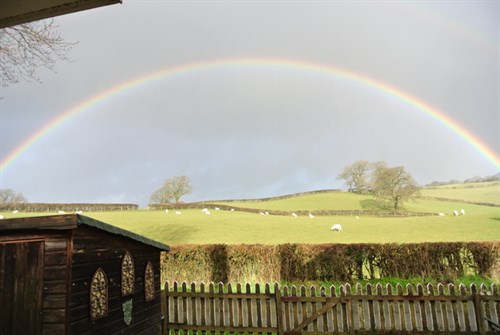
In this news item you will discover many examples to illustrate
what I mean.
Weather
The rain has been relentless, the ground is absolutely soaking
(as it was last January) and the leak in the conservatory has been
an ever present during the month. Winds have been regular and
devastating, taking off the polythene from the roof of our small
tunnel house, and in the second week of the month we had
concentrated thunderstorms and lightning, one of which lasted for 5
hours.
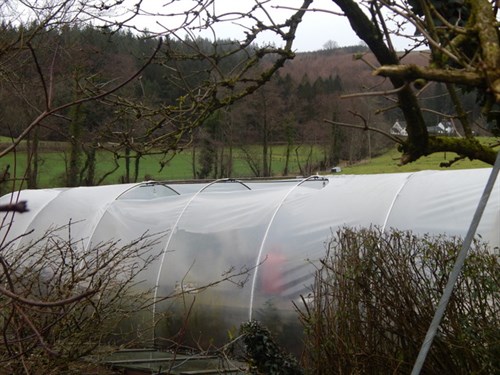
Raindrops hang forlornly (is that a word?) from acer
Orange Dream
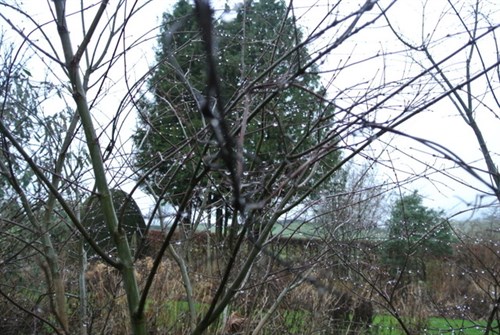
Incredibly being on overhead electricity supply we had no
lengthy power cuts. In many parts of the UK there has been criticsm
of the electicity network for failing to respond quickly enough to
loss of. power but here we had a brief interruption for just a few
minutes and received a phone call from our provider apologising for
the interruption.
What on earth has all this got to do with our gardening life at
Cilgwyn Lodge I hear you say. All weather has a bearing on it but
with no penetrating, long term frosts and with exceptionally mild
conditions growth has been incredible and there has been a lot of
activity in the countryside too.
Only 5 frosts min -4C and 9 days above 10C , max 11.6C
Garden update
There has been no chance, because of the state of the ground, to
get on with the weeding I had hoped for this month. The bittercress
is already looking too healthy and robust for my liking! I have
however taken the opportunity to do some fencing, repairing or
rebuilding more staging in the nursery, and cut back
overgrown or damaged shrubs.
An urgent task the day after Boxing Day when we lost the plastic
from the small tunnel, was to relocate all the plants from there
into the large tunnel where we just about found room for them.
Plans are in hand to rebuild the damaged tunnel as soon as
possible, retaining the orignal frame but strengthening it with
crop bars and covering with new polythene to the ground level
only. This avoids the need to dig an 50cm trench in ground that has
been compacted since we erected the tunnel in 1999. I was rather
lost without it to start with as it was my cosy "cwtch" in winter
to do my propagating
My "cwtch" in the small tunnel - note the
excellent ventilation in the roof!
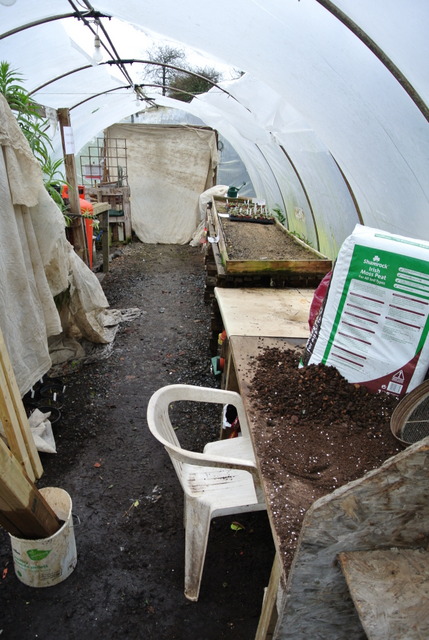
I have however been able to find a not so cosy corner in amongst
all the plants in the big tunnel. Just as well because the seed
sowing season always begins on or around 18 January, the date I
started work 49 years ago. Sweet peas are always the first to go in
hopefully to flower in early June, together with early cabbage
"Hispi", cauliflower "Snow Crown" and lettuce "Little Gem". These
are all germinated in gentle heat and should be through by the end
of the month.
Just enough space on the potting bench in the big
tunnel
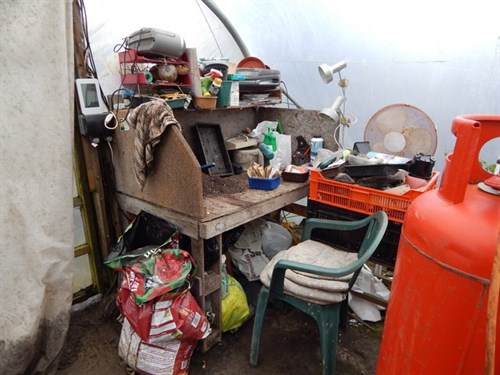
These are closely followed by a wide range of perennials, seed
collected trom the garden at Cilgwyn or distributed by The Hardy
Plant Society to members like us. I was pleased last autumn to be
able to supply 21 varieties to this annual process. More later
about the Society under the "Visits" heading. So far there about
140 varieties of seeds including veggies to be sown over the next 4
months, which will no doubt be substantially added to as more seed
comes in from The HPS and Chiltern Seeds, not to mention the other
seeds I am seduced by in nurseries and garden centres!
I have also had the opportunity through the British Hosta and
Hemerocallis Society to once again obtain daylily seed from
America, the result of crosses made by members of the American
Hemerocallis Society and generously made available by them to other
similar societies around the world. Big black coated seeds which
generally germinate easily and the offspring can flower within two
years.
Hellebore plants from seed sown 3 years ago are coming into
flower for the first time which is always exciting as you never
know just what you will get. Members of the buttercup family, the
ranunculaceae, are terribly promiscuous and unless they can be
micropropagated or very selectively hand pollinated, the offspring
may look nothing like the parents that produced them,
What's looking good?
The first snowdrops opened on 11 January and gradually since
then others have come into flower but perhaps not as quickly as
might be expected given how mild it has been. Just 3 years ago I
started to relocate from other parts of the garden to the Beech
Hedge Walk, our main late winter/early spring border, divisions
from large clumps elsewhere and already they are bulking up well.
They seem to enjoy the lightly shaded well drained soil and an
application of calcified seaweed, lime being one of the reasons why
there are so many fine snowdrop gardens in the Cotswolds. Although
I like snowdrops we don't grow many varieties of them as the
galanthophile bug hasn't bitten me yet (and with prices for some of
the rarer forms in the hundred of pounds I hope it never does!)
If you want to see a wide selection of snowdrops in our part
of Wales in a fabulous early Spring garden, make a beeline for
Gelli Uchaf. For more details go to Julian and Fiona's website at
thegardenimpressionists@wordpress.com
As regular readers will know hellebores are more my thing and I
have definitely been bitten by that bug!! They are all over the
garden and starting to bloom very well. It is interesting to note
that some forms are allways earlier than others depending on their
progeny. Most of the ones in the garden are helleborus x hybridus
forms but we do have helleborus niger, argutifolius, foetidus, X
sternii and ericsmithii, together with a few species (wild) forms
mostly from Italy and eastern parts of Europe. Much more on
hellebores next month.
A fine lemon anemone centred form always one of
the first to flower at Cilgwyn
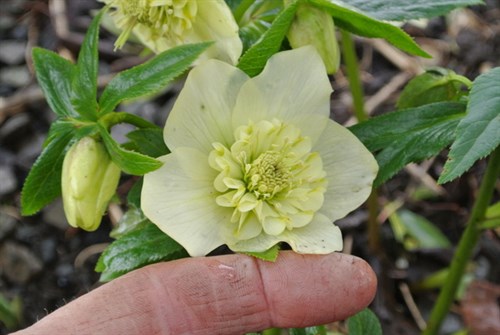
The ericsmithii group has recently been the focus of attention
for breeding programmes by nurseries and some attractive forms
continue to come onto the market. They are sterile hybrids of a
three way cross between h. argutifolius, h.lividus and h.niger. The
name of this group arises from the first breeder of them, Eric
Smith, who with the late Jim Archibald in the 1960's and early 70's
ran The Plantsman's Nursery in Dorset. Only in the last few years
has work been done to increase the number of cultivars available
and you wonder why it took them so long! as they are a welcome
addition to the market: very floriferous, generally with marbled
leaves (coming from h.lividus in the cross) and so far proving to
be hardy and vigorous. Look out for them in your local nursery or
garden centre.
Still the best form in this group in my opinion is "
Winter Moonbeam" with lovely creamy white flowers that fade to pink
and the lovely patterned leaves. Also look out for "Penny's Pink"
and "Anna's Red"
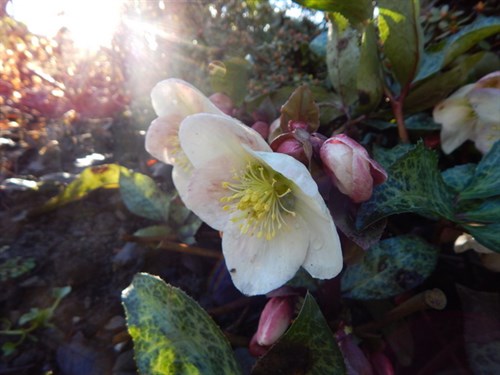
Cyclamen coum will always win top prizes at this time of year
for the sheer joy they bring on a dismal day, drifts of them in all
shades of pink or white bulking up every year from their seed
dispersed by ants or mice. If you don't grow these you must be
nuts!! Sorry - please do try them;you won't be disappointed. That
was much nicer!
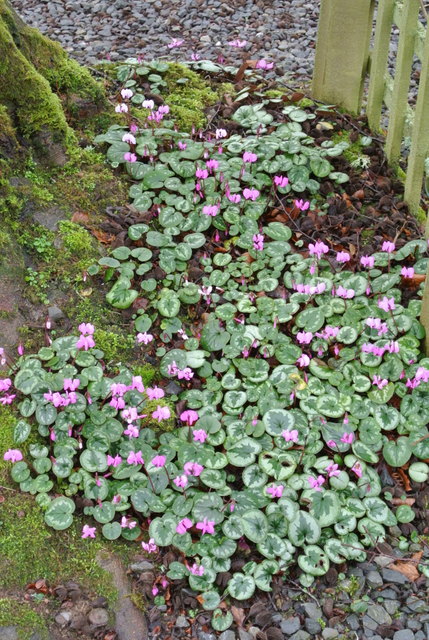
There are some good shrubs for winter flowering nearly all of
which have scent. We grow only a small selection of what is
availabale: hamamelis, shrubby lonicera and sarcococca with its
beguiling and far reaching scent form tiny white flowers and
fine glossy green leaves. It is for the latter is is commonly
known as winter or Christmas box. Daphnes are exceptional
shrubs/small trees but we just can't grow them here, as are drimys
in various forms and perhaps the one with the best and most
beguiling scent, edgeworthia chrysantha (but it requires just the
righty sort of protected spot). Some of these and a few early
rhododenrdrons you will see if you if you visit Gelli Uchaf in
February. Mahonias and viburnums too are other good winter
flowering shrubs.
Hamamelis "Arnold Promise" good flowers but not such a
good scent as the old form "Pallida"
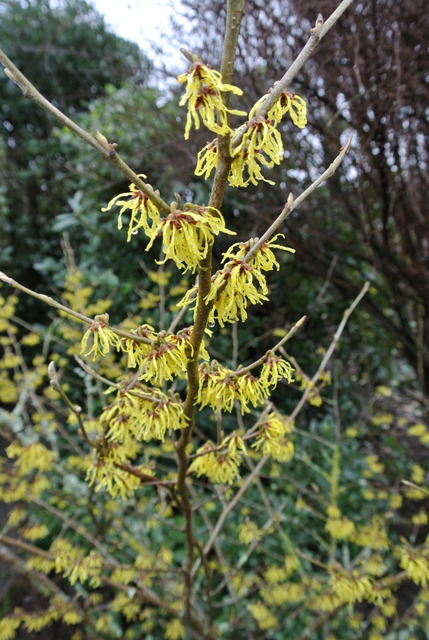
Hamamelis "Diane" is a good red but the flowers need a
green background to stand out. Good autumn colour
though.
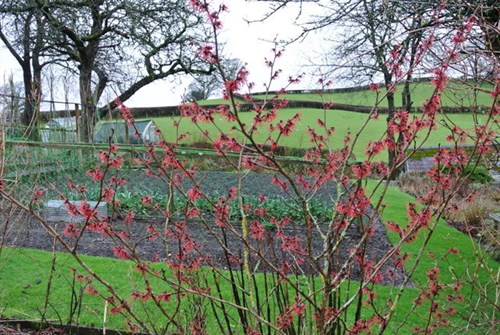
Sarcococca confusa in full bloom
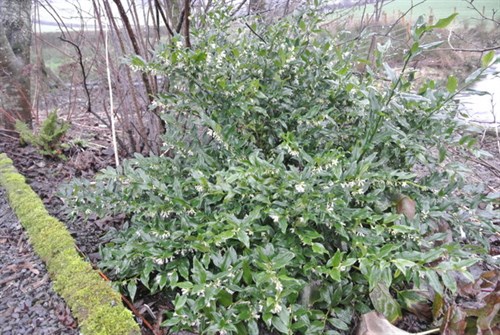
Nearby is this lovely evergreen fern polypodium
cambricum "Richard Kayse" totally hardy but late into leaf often
late June before it wakes up!
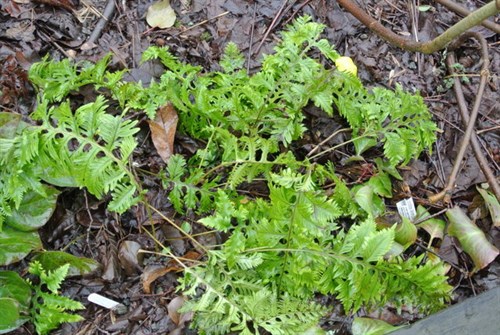
Just the joy of a single flower on a plant that shouldn't be
flowering at this time of year can lift the spirits on the 37th
consecutive day of rain! That is the beauty of a protected heated
tunnel or greenhouse. There is also the joy of remembering
propagating it or the generosity of a kind gardener who passed on a
few cuttings at the height of summer. The plant I have in mind is a
rare impatiens.
Impatiens apiculata 50cms tall from cuttings taken last
June
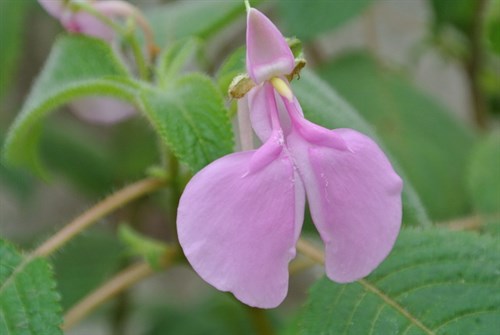
Other little treasures in the big tunnel are this
gorgeous primula "John Fielding" a rare hybrid form which is
totally hardy but I keep a few inside just to be able to
appreciate the flowers close up.
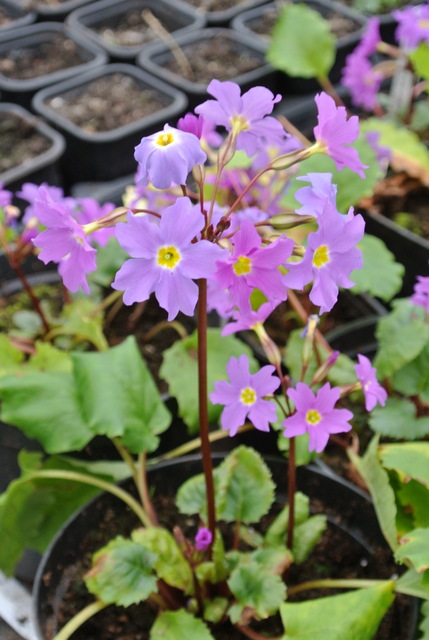
This bright and cheerful aeonium haworthii "Variegatum"
on the succulent bench
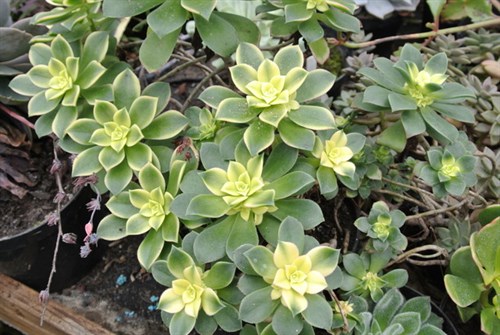
and finally this dainty abutillon magapotanicum
"Wakehurst" still flowering its heart out!
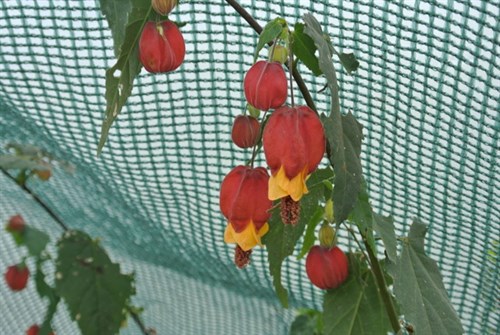
I have saved the really best until last. We have 22 types of
vegetables still available, fresh from the garden, from store in
the stone shed, from the freezer or dried. I find it difficult to
believe but it is the best result we have ever had thanks to the
mild winter and a dry autumn which allowed us to harvest all the
root crops for storing in dry peat or sharp sand. We also
continued to have tomatoes from the tunnel until 12 January and
still have a few sweet peppers from a purple form that haven't
fully coloured but still taste good (no surprise given the lack of
sunshine). I am so pleased that I am listing what we have in full
(time to have a drink, alcoholic if you like!)
Fresh: Cabbages "Tundra" and "Meribel"
(January King type). 2 varieties of Brussels Sprouts, Leeks,
Parsnips, Swede, Salsify and Purple Sprouting still to come.
From store: Potatoes, Carrots, Celeriac,
Beetroot, Mooli Radish, Onions, Shallots, Garlic
From Freezer: Peas, Broad Beans. Sweetcorn and
puree from the Tomatoes
Dried: Berlotti Beans
The remaining leeks in a very soggy
bed!
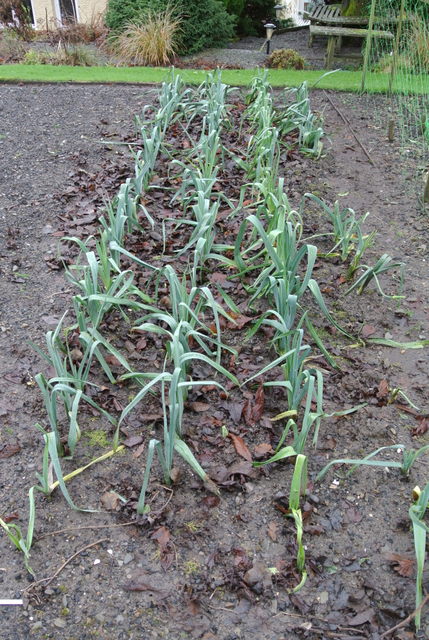
Wildlife and countryside
The plants and animals all around us are enjoying the mild
weather. The grass is green and still growing, and there are worm
casts all over the lawns as there has been no significantly cold
weather to send the worms deeper. We don't walk on the lawns any
more than we have to at this time of year to avoid compaction and
it also flattens the worm casts which looks unsightly and can make
work later on.
The fish in the House Pond are active and looking for food every
day. I generally don't feed them in winter but just a little each
day won't do them any harm. The fish in the Koi Pond however are
inactive barely mowing from ther spot by the water outlet which is
their winter default position so they are not fed.
House pond fish looking for food
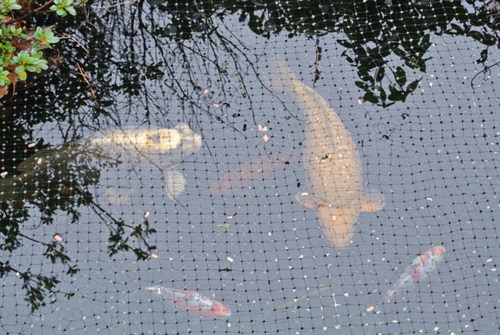
and the Koi pond fish a state of winter
torpor
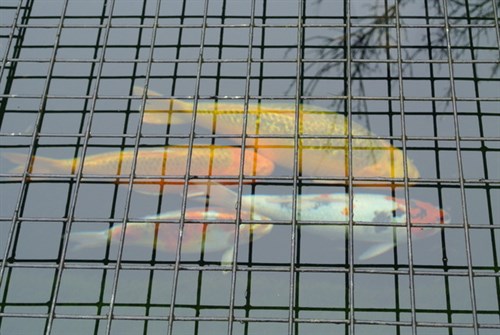
The catkins on the hazels are full of pollen which glows when
caught by the very occasional late afternoon sunshine and there are
still masses of berries on the holly trees. I have seen no
significant numbers of fieldfares and redwings which in a colder
winter would have usually devoured all the berries.
On a bright, mild morning it is good to hear birdsong all around
and at twilight the owls hooting from the nearby chestnut tree. As
always the "drama queen" blackbirds are the noisiest, shrieking and
flying low to find a safe roost for the night.
Last week we had a rarely sighted tree creeper fly into a window
and stun itself. It is not very often you have the chance to view
these small birds at close quarters as most of their lives are
spent in trees where they feed on insects hiding in the bark. They
are prettier close up than when briefly glimpsed in a tree, with
rich brown tones, a white breast and a long bill. Fortunately there
was just time to take some pics before it flew off in to an apple
tree apparently none the worse for its accident. In the gardens we
also have the nutchach, a much bigger slate grey and chestnut
coloured bird that is a regular visitor to bird feeders. Unlike
tree creepers their method of feeding in trees is to start at the
top and work down, whereas the tree creeper alwatys goes up the
trunk
The lovely little tree creeper
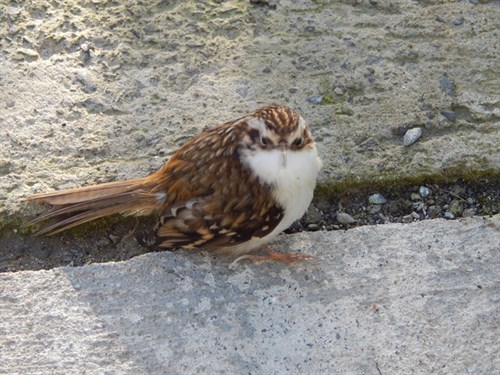
Having thought we had seen the back of the rabbits a few
weeks ago, they have recently returned with a vegence digging holes
everywhere and generally making a nuisance of themselves. As I
never see them whatever time of the day or night I look for them, I
have resorted to a secret deterrent - a sumo cat! This big boy will
soon make short work of the bunnies!
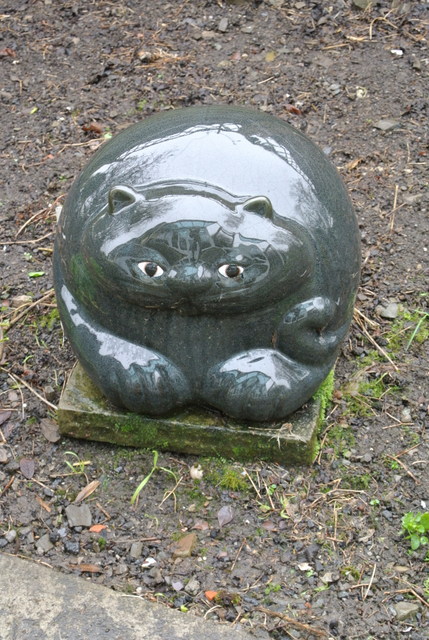
and he has a little helper to carry away the
remains!!
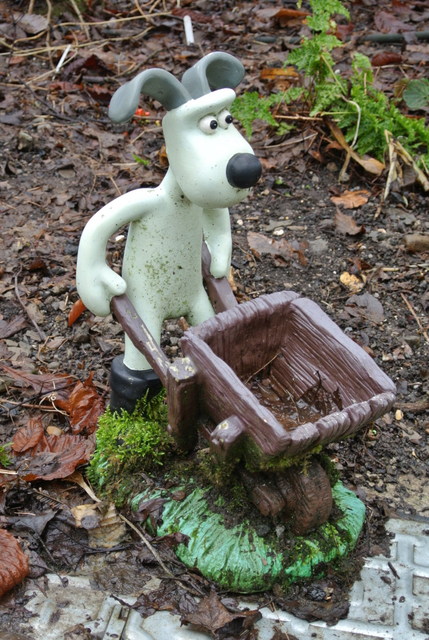
There was some frog spawn on the bank of the Paddock Pond on 12
January but none in the pond nor any signs of frogs. If it
stays mild it won't be long before the spawning season will begin
in earnest.
A few days later I noticed the remains of a few waterlily
flowers on the bank and some pondweed. Close by there were some
fish scales and a telltale large footprint in the mud - an otter
had been for supper! We have had more visits in January than at any
other time of year so I should know better and have put
up the electric fence before then. Once it is in place the otters
stay away. I was intrigued why the waterlily flowers had clearly
been taken to the bank and some of them partially eaten as I have
never seen this before. A Google search has failed to come up
with an answer, although in the USA some pond owners report
incidents of waterlilies being eaten by raccoons! Have thay arrived
in the UK as the result of climate change?!!
The electric fence in p;ace and look at the colour
on the grass!
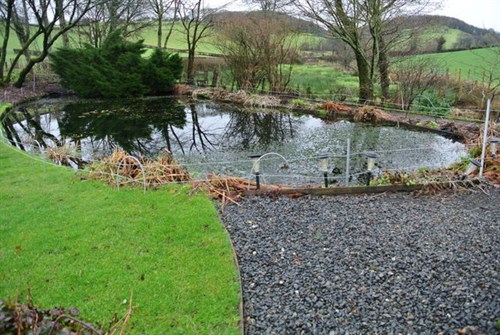
Finally a sure sign of the approach of Spring is the arrival of
the first lambs. All lambing is now done in barns and the lambs are
not turned out until they are strong enough to cope with vagaries
of the weather so it will be a while yet before we have the joy of
seeing them in the fields again. Pics soon but in the meantime
check out these ewes colourfully dressed up in all their finery.
(The coloured marks indicating the farm ownership (red) and the red
or the purple markings whether they are carrying twins (blue) or
triplets(purple).
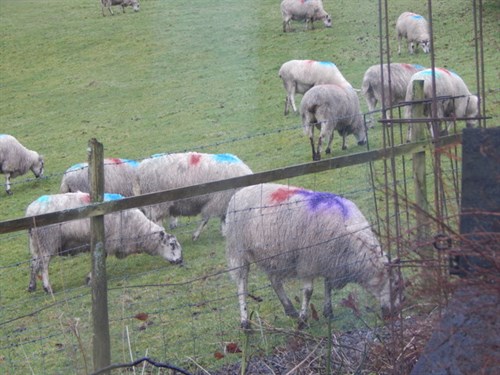
In spite of all the early promise of Spring, I am convinced that
Winter still has time to bare its teeth which with so much forward
growth will not be good news.
Visits
One talk this month (Designing with Perennials - Colour Schemes
for the Flower Garden) to the Hereford and Mid Wales Group of The
Hardy Plant Society which was a lively and enjoyable meeting. Some
excellent discussion points and questions from a very good
attendance.
There is usually a good raffle at most HPS Group
Meetings but this one was something special. A member had donated
this wonderful specimen of a very challenging winter flowering
clematis, urophylla "Winter Beauty" considered by many experts to
be almost impossible to flower outdoors in the UK. The donor
has the mother plant on a wall of his house 800 feet up in the
Black Mountains. Such a delight for me to see it in flower for the
first time but sadly I did not win the raffle!
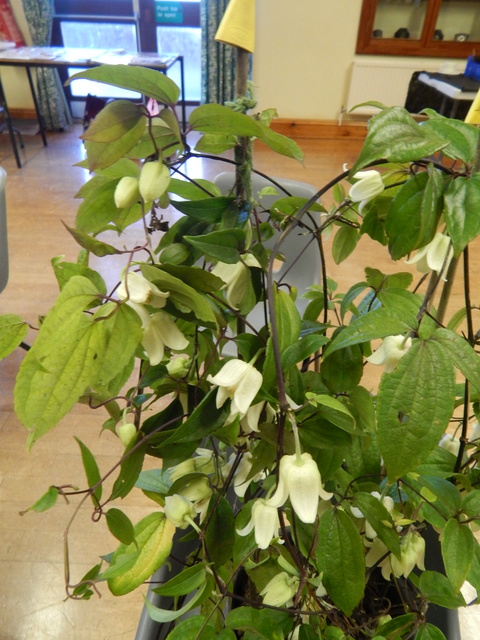
We have been members of the HPS for many years which has a large
membership across the UK and beyond with 42 regional groups that
members can join if they wish. They organise and parrticipate in
local horticultural events and make stands at all the major shows
including Chelsea and other RHS events. There are Newsletters,
Journals and Bulletins and plant specific booklets are published.
One of the highlights is the annual Seed Exchange when members
contribute seeds from their own gardens for distribution. The seed
list usually extends to over 2000 varieties including many rare or
unusual forms often unobtainable elsewhere, all for a cost of £5
for 20 packets with more available at the end of the normal
distribution period. The whole process is completed in just 4
months ensuring that the seed is fresh which in my experience
ensures optimum germination rates. Some of our most prized plants
have come from HPS seed. We warmly recommend membership for any
plant lover and for more information about the Society please visit
the website at www.hardy-plant.org.uk
Last Saturday we visited Ashwood Nurseries near Kidderminster
which is an example of what all garden centre/nurseries should be
like. Many plants (including rare and unusual) grown on site, great
tea rooms and gift shop and knowledgeable and helpful staff. The
Nursery has achieved worldwide fame particularly for its
hellebores and is one of the leading breeders but they also
specialise in other plants too, auriculas being one of them.
This lovely display of floated auriculaflowers in the
alpine house took the breath away. They can last for up to a week
if kept cool. Of course this is also the usual way of
displaying hellebores in the house.
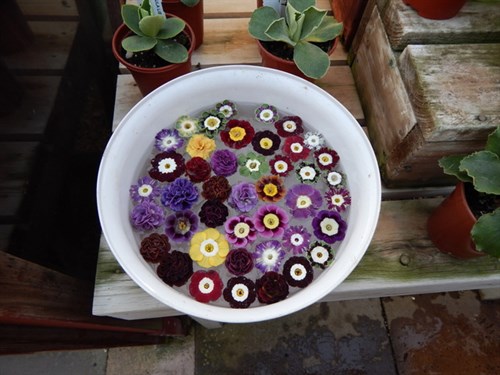
Back to hellebores, each year in January and February the public
have the opportunity of guided tours of their breeding
houses and tunnels and to have the pick of some of the finest forms
before they go out to the general sales areas. The sight of
10,000 top quality hellebores in bloom is quite an experience and
if you are not already hooked on hellebores by the time you finish
the tour you will be! But be warned they can be seriously addictive
and some of them expensive to buy but as they can live for well
over 20 years they represent excellent value. Find out more about
the nursery go to www.ashwoodnurseries.com
The lecture in the propagation house
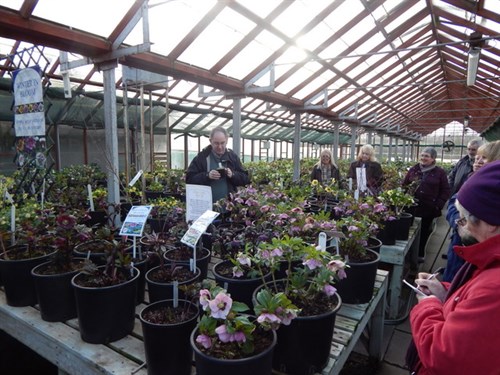
The main tunnel holding the plants ready for
sale
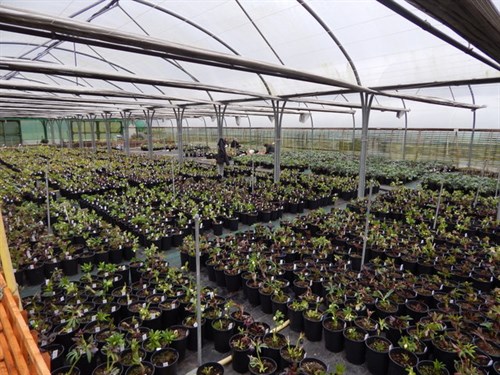
Some of Ashwoods famed varieties, this one has been
named "Neon", an exception to the normal practice of the nursery
which says all you need to know about how special they consider it
to be - £25.99 and its yours!
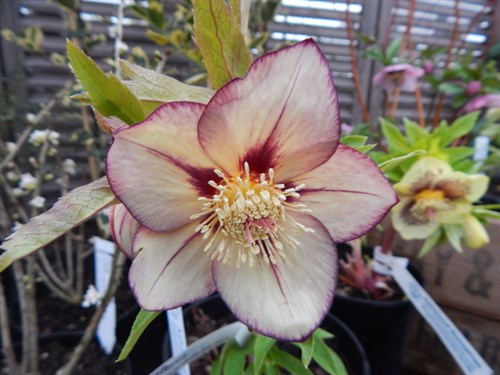
Aswoods have some of the best yellows in
cultivation and this one typifies the quality on offer
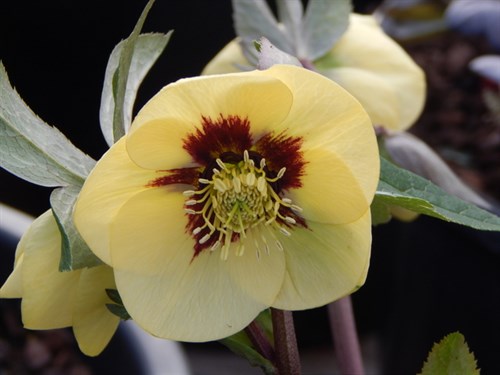
This form of helleborus niger is a strain introduced by
the nursery and has a semi double form.
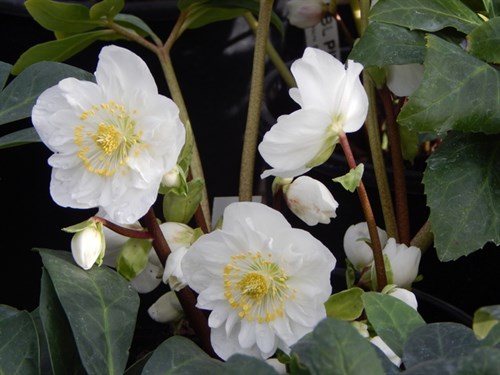
Events in February include 3 talks to Gardening Clubs, a
Question Time for West Wales Country Gardeners and the annual
highlight of the month, The Winter Gardening Weekend in Llandysul
from 21 -23 February. Plants for sale, crafts, refreshments, a
stage display of winter flowering plants by Farmyard Nurseries and
a range of speakers each day including yours truly (on Growing
Vegetables on the 22nd) . For more information go to www.llandysul-ponttyweli.co.uk and
click on the link to the 2014 Wnter Gardening Weekend.